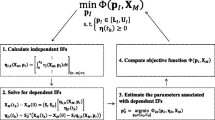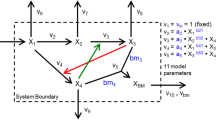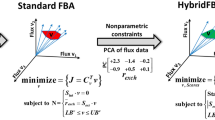Abstract
Data integration to model-based description of biological systems incorporating gene dynamics improves the performance of microbial systems. Bioprocess performance, typically predicted using empirical Monod-type models, is essential for a sustainable bioeconomy. To replace empirical models, we updated a hybrid gene regulatory network-growth kinetic model, predicting aromatic pollutants degradation and biomass growth in Pseudomonas putida mt-2. We modeled a complex biological system including extensive information to understand the role of the regulatory elements in toluene biodegradation and biomass growth. The updated model exhibited extra complications such as the existence of oscillations and discontinuities. As parameter estimation of complex biological models remains a key challenge, we used the updated model to present a dual-parameter identification approach (the ‘dual approach’) combining two independent methodologies. Approach I handled the complexity by incorporation of demonstrated biological knowledge in the model-development process and combination of global sensitivity analysis and optimisation. Approach II complemented Approach I handling multimodality, ill-conditioning and overfitting through regularisation estimation, global optimisation, and identifiability analysis. To systematically quantify the biological system, we used a vast amount of high-quality time-course data. The dual approach resulted in an accurately calibrated kinetic model (NRMSE: 0.17055) efficiently handling the additional model complexity. We tested model validation using three independent experimental data sets, achieving greater predictive power (NRMSE: 0.18776) than the individual approaches (NRMSE I: 0.25322, II: 0.25227) and increasing model robustness. These results demonstrated data-driven predictive modeling potentially leading to bioprocess’ model-based control and optimisation.







Similar content being viewed by others
References
Almquist J, Cvijovic M, Hatzimanikatis V et al (2014) Kinetic models in industrial biotechnology—Improving cell factory performance. Metab Eng 24:38–60. https://doi.org/10.1016/j.ymben.2014.03.007
Chakrabarti A, Miskovic L, Soh KC, Hatzimanikatis V (2013) Towards kinetic modeling of genome-scale metabolic networks without sacrificing stoichiometric, thermodynamic and physiological constraints. Biotechnol J 8:1043–1057. https://doi.org/10.1002/biot.201300091
Smallbone K, Mendes P (2013) Large-scale metabolic models: from reconstruction to differential equations. Ind Biotechnol 9:179–184. https://doi.org/10.1089/ind.2013.0003
Wiechert W, Noack S (2011) Mechanistic pathway modeling for industrial biotechnology: challenging but worthwhile. Curr Opin Biotechnol 22:604–610. https://doi.org/10.1016/j.copbio.2011.01.001
Kovárová-Kovar K, Egli T (1998) Growth kinetics of suspended microbial cells: from single-substrate-controlled growth to mixed-substrate kinetics. Microbiol Mol Biol Rev 62:646–666. https://doi.org/10.1128/mmbr.62.3.646-666.1998
Rogers JB, Reardon KF (2000) Modeling substrate interactions during the biodegradation of mixtures of toluene and phenol by Burkholderia species JS150. Biotechnol Bioeng 70:428–435. https://doi.org/10.1002/1097-0290(20001120)70:4%3c428:AID-BIT8%3e3.0.CO;2-4
Chen C, Le H, Goudar CT (2016) Integration of systems biology in cell line and process development for biopharmaceutical manufacturing. Biochem Eng J 107:11–17. https://doi.org/10.1016/j.bej.2015.11.013
Lee JW, Kim TY, Jang YS et al (2011) Systems metabolic engineering for chemicals and materials. Trends Biotechnol 29:370–378. https://doi.org/10.1016/j.tibtech.2011.04.001
Park JH, Lee SY, Kim TY, Kim HU (2008) Application of systems biology for bioprocess development. Trends Biotechnol 26:404–412. https://doi.org/10.1016/j.tibtech.2008.05.001
Ballerstedt H, Volkers RJM, Mars AE et al (2007) Genomotyping of Pseudomonas putida strains using P. putida KT2440-based high-density DNA microarrays: implications for transcriptomics studies. Appl Microbiol Biotechnol 75:1133–1142. https://doi.org/10.1007/s00253-007-0914-z
Pieper DH, Martins Dos Santos VAP, Golyshin PN (2004) Genomic and mechanistic insights into the biodegradation of organic pollutants. Curr Opin Biotechnol 15:215–224. https://doi.org/10.1016/j.copbio.2004.03.008
Ewering C, Heuser F, Benölken JK et al (2006) Metabolic engineering of strains of Ralstonia eutropha and Pseudomonas putida for biotechnological production of 2-methylcitric acid. Metab Eng 8:587–602. https://doi.org/10.1016/j.ymben.2006.05.007
Nikel PI, Chavarría M, Danchin A, de Lorenzo V (2016) From dirt to industrial applications: pseudomonas putida as a Synthetic Biology chassis for hosting harsh biochemical reactions. Curr Opin Chem Biol 34:20–29. https://doi.org/10.1016/j.cbpa.2016.05.011
Ramos JL, Marqués S, Timmis KN (1997) Transcriptional control of the pseudomonas Tol plasmid catabolic operons is achieved through an interplay of host factors and plasmid-encoded regulators. Annu Rev Microbiol 51:341–373. https://doi.org/10.1146/annurev.micro.51.1.341
Timmis KN (2002) Pseudomonas putida: a cosmopolitan. Environ Microbiol 4:779–781
Koutinas M, Lam MC, Kiparissides A et al (2010) The regulatory logic of m-xylene biodegradation by Pseudomonas putida mt-2 exposed by dynamic modelling of the principal node Ps/Pr of the TOL plasmid. Environ Microbiol 12:1705–1718. https://doi.org/10.1111/j.1462-2920.2010.02245.x
Koutinas M, Kiparissides A, Silva-Rocha R et al (2011) Linking genes to microbial growth kinetics—an integrated biochemical systems engineering approach. Metab Eng 13:401–413. https://doi.org/10.1016/j.ymben.2011.02.001
Tsipa A, Koutinas M, Pistikopoulos EN, Mantalaris A (2016) Transcriptional kinetics of the cross-talk between the ortho-cleavage and TOL pathways of toluene biodegradation in Pseudomonas putida mt-2. J Biotechnol 228:112–123. https://doi.org/10.1016/j.jbiotec.2016.03.053
Tsipa A, Koutinas M, Vernardis S, Mantalaris A (2017) The impact of succinate trace on pWW0 and ortho-cleavage pathway transcription in Pseudomonas putida mt-2 during toluene biodegradation. Bioresour Technol 234:397–405. https://doi.org/10.1016/j.biortech.2017.03.082
Tsipa A, Koutinas M, Usaku C, Mantalaris A (2018) Optimal bioprocess design through a gene regulatory network—growth kinetic hybrid model: towards replacing Monod kinetics. Metab Eng 48:129–137. https://doi.org/10.1016/j.ymben.2018.04.023
Cowles CE, Nichols NN, Harwood CS (2000) BenR, a Xy1S homologue, regulates three different pathways of aromatic acid degradation in Pseudomonas putida. J Bacteriol 182:6339–6346. https://doi.org/10.1128/JB.182.22.6339-6346.2000
Cuskey SM, Sprenkle AB (1988) Benzoate-dependent induction from the OP2 operator-promoter region of the TOL plasmid pWWO in the absence of known plasmid regulatory genes. J Bacteriol 170:3742–3746. https://doi.org/10.1128/jb.170.8.3742-3746.1988
Li D, Yan Y, Ping S et al (2010) Genome-wide investigation and functional characterization of the -ketoadipate pathway in the nitrogen-fixing and root-associated bacterium Pseudomonas stutzeri A1501. BMC Microbiol. https://doi.org/10.1186/1471-2180-10-36
Balsa-Canto E, Alonso AA, Banga JR (2010) An iterative identification procedure for dynamic modeling of biochemical networks. BMC Syst Biol. https://doi.org/10.1186/1752-0509-4-11
Kiparissides A, Koutinas M, Kontoravdi C et al (2011) “Closing the loop” in biological systems modeling-from the in silico to the in vitro. Automatica 47:1147–1155. https://doi.org/10.1016/j.automatica.2011.01.013
Tarantola A (1987) Inverse problem theory: methods for data fitting and model parameter estimation. Elsevier, Amsterdam, New York
Villaverde AF, Banga JR (2014) Reverse engineering and identification in systems biology: strategies, perspectives and challenges. J R Soc Interface. https://doi.org/10.1098/rsif.2013.0505
Chen WW, Niepel M, Sorger PK (2010) Classic and contemporary approaches to modeling biochemical reactions. Genes Dev 24:1861–1875. https://doi.org/10.1101/gad.1945410
Gábor A, Banga JR (2015) Robust and efficient parameter estimation in dynamic models of biological systems. BMC Syst Biol. https://doi.org/10.1186/s12918-015-0219-2
Ljung L, Chen T (2013) Convexity issues in system identification. IEEE Int Conf Control Autom ICCA. https://doi.org/10.1109/ICCA.2013.6565206
Moles CG, Mendes P, Banga JR (2003) Parameter estimation in biochemical pathways: a comparison of global optimization methods. Genome Res 13:2467–2474. https://doi.org/10.1101/gr.1262503
Pitt JA, Banga JR (2019) Parameter estimation in models of biological oscillators: an automated regularised estimation approach. BMC Bioinformat 20:1–17. https://doi.org/10.1186/s12859-019-2630-y
Weiss R, Basu S, Hooshangi S et al (2003) Genetic circuit building blocks for cellular computation, communications, and signal processing. Nat Comput 2:47–84. https://doi.org/10.1023/A:1023307812034
Alon U (2006) An introduction to systems biology. Chapman & Hall/CRC, Boca Raton
Bertoni G, Marqués S, De Lorenzo V (1998) Activation of the toluene-responsive regulator XylR causes a transcriptional switch between σ54 and σ70 promoters at the divergent Pr/Ps region of the TOL plasmid. Mol Microbiol 27:651–659. https://doi.org/10.1046/j.1365-2958.1998.00715.x
Devos D, Garmendia J, De Lorenzo V, Valencia A (2002) Deciphering the action of aromatic effectors on the prokaryotic enhancer-binding protein XylR: a structural model of its N-terminal domain. Environ Microbiol 4:29–41. https://doi.org/10.1046/j.1462-2920.2002.00265.x
Bertoni G, Pérez-Martín J, De Lorenzo V (1997) Genetic evidence of separate repressor and activator activities of the XylR regulator of the TOL plasmid, pWW0, of Pseudomonas putida. Mol Microbiol 23:1221–1227. https://doi.org/10.1046/j.1365-2958.1997.3091673.x
Domínguez-Cuevas P, Marín P, Busby S et al (2008) Roles of effectors in XylS-dependent transcription activation: intramolecular domain derepression and DNA binding. J Bacteriol 190:3118–3128. https://doi.org/10.1128/JB.01784-07
Marques S, Holtel A, Timmis KN, Ramos JL (1994) Transcriptional induction kinetics from the promoters of the catabolic pathways of TOL plasmid pWWO of Pseudomonas putida for metabolism of aromatics. J Bacteriol 176:2517–2524
Silva-Rocha R, De Lorenzo V (2012) Broadening the signal specificity of prokaryotic promoters by modifying cis-regulatory elements associated with a single transcription factor. Mol BioSyst 8:1950–1957. https://doi.org/10.1039/c2mb25030f
Ferrell JE, Tsai TYC, Yang Q (2011) Modeling the cell cycle: why do certain circuits oscillate? Cell 144:874–885. https://doi.org/10.1016/j.cell.2011.03.006
Kontoravdi C, Pistikopoulos EN, Mantalaris A (2010) Systematic development of predictive mathematical models for animal cell cultures. Comput Chem Eng 34:1192–1198. https://doi.org/10.1016/j.compchemeng.2010.03.012
Sobol IM (2001) Global sensitivity indices for nonlinear mathematical models and their Monte Carlo estimates. Math Comput Simul 55:271–280. https://doi.org/10.1016/S0378-4754(00)00270-6
Sidoli FR, Mantalaris A, Asprey SP (2005) Toward global parametric estimability of a large-scale kinetic single-cell model for mammalian cell cultures. Ind Eng Chem Res 44:868–878. https://doi.org/10.1021/ie0401556
Ziehn T, Tomlin AS (2009) GUI-HDMR—a software tool for global sensitivity analysis of complex models. Environ Model Softw 24:775–785. https://doi.org/10.1016/j.envsoft.2008.12.002
Seber GAF, Wild CJ (2003) Nonlinear regression. Wiley, Hoboken, p 62
Fröhlich F, Theis FJ, Rädler JO, Hasenauer J (2017) Parameter estimation for dynamical systems with discrete events and logical operations. Bioinformatics 33:1049–1056. https://doi.org/10.1093/bioinformatics/btw764
Serban R, Hindmarsh AC (2005) CVODES: the sensitivity-enabled ODE solver in SUNDIALS. In: Volume 6: 5th international conference on multibody systems, nonlinear dynamics, and control, parts A, B, and C, pp 257–269
Fröhlich F, Kaltenbacher B, Theis FJ, Hasenauer J (2017) Scalable parameter estimation for genome-scale biochemical reaction networks. PLoS Comput Biol 13:1–18. https://doi.org/10.1371/journal.pcbi.1005331
Egea JA, Martí R, Banga JR (2010) An evolutionary method for complex-process optimization. Comput Oper Res 37:315–324. https://doi.org/10.1016/j.cor.2009.05.003
Dennis JE, Gay DM, Welsch RE (1981) Algorithm 573: nL2SOL—an adaptive nonlinear least-squares algorithm [E4]. ACM Trans Math Softw 7:369–383. https://doi.org/10.1145/355958.355966
Egea JA, Henriques D, Cokelaer T et al (2014) MEIGOR : a software suite based on metaheuristics for global optimization in systems biology and bioinformatics. In: Continuous and mixed-integer problems: Enhanced Scatter Search, pp 1–33
Gábor A, Villaverde AF, Banga JR (2017) Parameter identifiability analysis and visualization in large-scale kinetic models of biosystems. BMC Syst Biol 11:1–16. https://doi.org/10.1186/s12918-017-0428-y
Pérez-Pantoja D, Kim J, Silva-Rocha R, de Lorenzo V (2015) The differential response of the Pben promoter of Pseudomonas putidamt-2 to BenR and XylS prevents metabolic conflicts in m-xylene biodegradation. Environ Microbiol 17:64–75. https://doi.org/10.1111/1462-2920.12443
Campbell K, Xia J, Nielsen J (2017) The impact of systems biology on bioprocessing. Trends Biotechnol 35:1156–1168. https://doi.org/10.1016/j.tibtech.2017.08.011
Raue A, Kreutz C, Theis FJ, Timmer J (2013) Joining forces of Bayesian and frequentist methodology: a study for inference in the presence of non-identifiability. Philos Trans R Soc A Math Phys Eng Sci. https://doi.org/10.1098/rsta.2011.0544
Geier F, Fengos G, Felizzi F, Iber D (2012) Analyzing and constraining signaling networks: parameter estimation for the user. In: Computational modeling of signaling networks, pp 23–39
Joshi M, Seidel-Morgenstern A, Kremling A (2006) Exploiting the bootstrap method for quantifying parameter confidence intervals in dynamical systems. Metab Eng 8:447–455. https://doi.org/10.1016/j.ymben.2006.04.003
Villaverde AF, Raimúndez E, Hasenauer J, Banga JR (2019) A comparison of methods for quantifying prediction uncertainty in systems biology. IFAC-PapersOnLine 52:45–51. https://doi.org/10.1016/j.ifacol.2019.12.234
Acknowledgements
This project has received funding from the European Union’s Horizon 2020 research and innovation program under grant agreement 675585 (Marie Skłodowska-Curie ITN “SymBioSys”). JRB also acknowledges funding from the Spanish Ministry of Science, Innovation and Universities and the European Union FEDER under project grant SYNBIOCONTROL (DPI2017-82896-C2-2-R). Author JAP has been a Marie Skłodowska-Curie ESR at IIM-CSIC (Spain).
Author information
Authors and Affiliations
Corresponding authors
Ethics declarations
Conflict of interest
The authors declare that they have no conflicts of interest.
Additional information
Publisher's Note
Springer Nature remains neutral with regard to jurisdictional claims in published maps and institutional affiliations.
Electronic supplementary material
Below is the link to the electronic supplementary material.
Rights and permissions
About this article
Cite this article
Tsipa, A., Pitt, J.A., Banga, J.R. et al. A dual-parameter identification approach for data-based predictive modeling of hybrid gene regulatory network-growth kinetics in Pseudomonas putida mt-2. Bioprocess Biosyst Eng 43, 1671–1688 (2020). https://doi.org/10.1007/s00449-020-02360-2
Received:
Accepted:
Published:
Issue Date:
DOI: https://doi.org/10.1007/s00449-020-02360-2




